
FCRA: How an Emergency-era law will alter the face of social work in India
As Amnesty International pulls out of India, accusing the government of a 'witch hunt', smaller grassroots organisations also struggle under new funding regulations, putting both programmes and jobs on the line
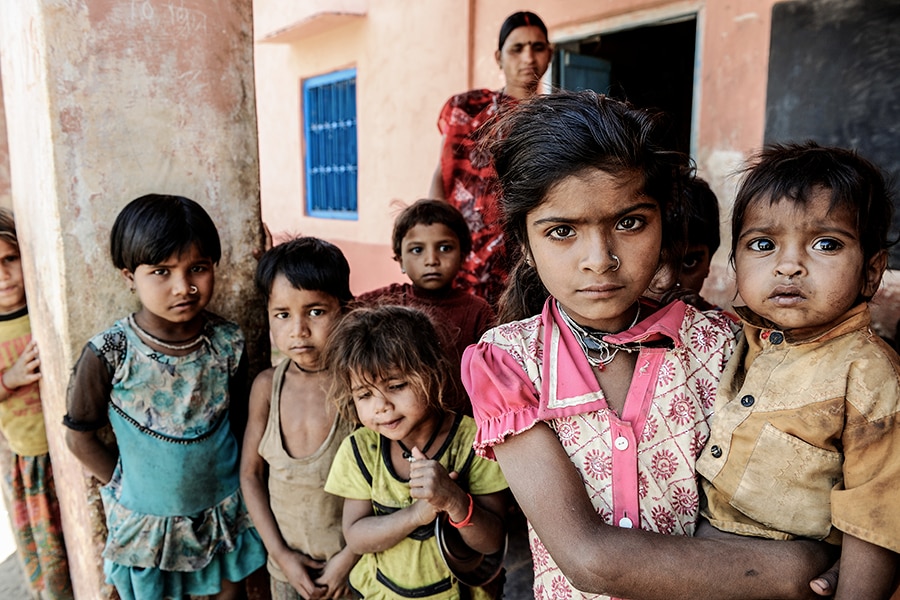 The Foreign Contribution (Regulation) Amendment Bill, 2020, tightens the noose around the social sector with respect to compliance processes. Representative Image: Frédéric Soltan/Corbis via Getty Images
The Foreign Contribution (Regulation) Amendment Bill, 2020, tightens the noose around the social sector with respect to compliance processes. Representative Image: Frédéric Soltan/Corbis via Getty Images
In the aftermath of the FCRA amendment being passed, Amnesty International halted India operations. The humans rights organisation accused the government of a "witch hunt". The government had previously investigated Amnesty over suspicions that the group was violating foreign funding laws and froze its bank accounts earlier this month, which the non-profit condemned as a crackdown on dissent
******
The year had already started off on the wrong foot for Swarup Ghosh. The founder of non-profit Tomorrow’s Foundation in West Bengal, which works in primary education for marginalised children and skill development for young adults from vulnerable backgrounds, had to lay off five people shortly after the national lockdowns. A large software company had pulled out funding for an in-school programme for children, as the money was being redirected to PM-Cares and Covid-19 relief work.
As Ghosh began requesting corporate donors to at least provide enough funding to cover staff salaries and dipped into the contingency funds, another major setback caught him off-guard last week. On September 21, the Lok Sabha passed the Foreign Contribution (Regulation) Amendment (FCRA) Bill 2020, which redefined terms for how non-governmental organisations (NGOs) can accept, transfer and utilise foreign donations and contributions. It was ratified by the Rajya Sabha on September 23 and the gazette notification was out on September 30.
Ghosh is already thinking about ways to re-calibrate operations in ways that will cause minimum damage. “About 40 percent of our funds come through large FCRA-registered donors, including Save the Children, the United Nations Children's Fund (UNICEF) and The Hans Foundation,” he says. The funding shortfall might result in about 25 percent of team members facing salary cuts or layoffs, and about a scaling down of about 40 percent of projects currently running in West Bengal, Chhattisgarh and the North-East. “Right now, everyone is just confused as to how this Act will finally be implemented. I understand there is a need to ensure transparency and stop misuse of foreign funds, but this way, even organisations doing good work are getting impacted.”

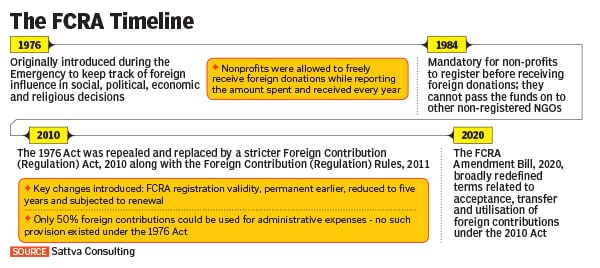 Stricter over time
Stricter over time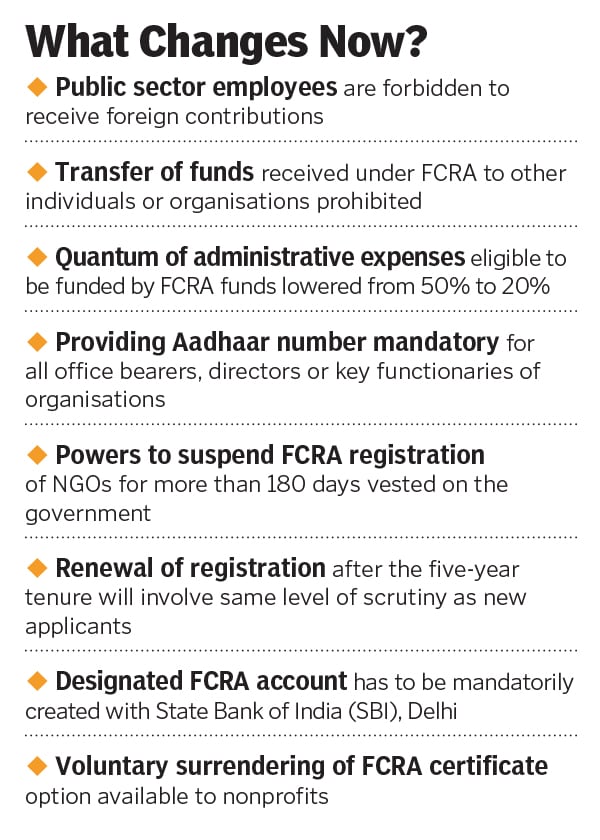 As the Bill was being passed in the Lok Sabha, Minister of State for Home, Nityanand Rai [who had introduced the Bill on behalf of Union Home minister Amit Shah], stated that the government’s intention was to bring about “greater transparency and stop misuse of foreign contributions by some people”. He said a legislation of this nature is required for the government’s vision of an Atmanirbhar Bharat and to make sure the funds are spent in the right direction and for the right causes.
As the Bill was being passed in the Lok Sabha, Minister of State for Home, Nityanand Rai [who had introduced the Bill on behalf of Union Home minister Amit Shah], stated that the government’s intention was to bring about “greater transparency and stop misuse of foreign contributions by some people”. He said a legislation of this nature is required for the government’s vision of an Atmanirbhar Bharat and to make sure the funds are spent in the right direction and for the right causes.
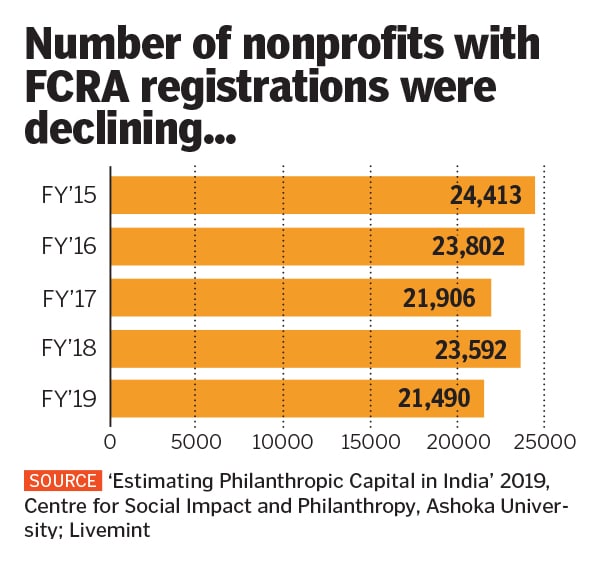 “More than 90 percent of these 20,000-odd non-profits [registered under the FCRA] receive a grant size of less than Rs1 crore. By increasing the regulatory barriers around these small non-profits, the policy is channelling limited state capacity on a needle search. The ease of doing civic work just regressed back to the License Raj,” says the founder of a Delhi-based non-profit funded by a global impact fund, who did not want to be identified.
“More than 90 percent of these 20,000-odd non-profits [registered under the FCRA] receive a grant size of less than Rs1 crore. By increasing the regulatory barriers around these small non-profits, the policy is channelling limited state capacity on a needle search. The ease of doing civic work just regressed back to the License Raj,” says the founder of a Delhi-based non-profit funded by a global impact fund, who did not want to be identified.
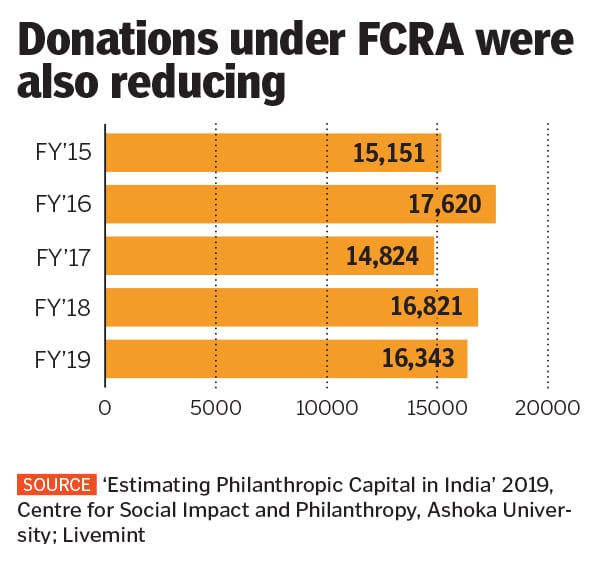 Her colleague Aarti Mohan, co-founder of Sattva, says that a demand for additional compliance will have to be backed up with more resources and support systems for non-profits, just like businesses and startups have organisations like Nasscom and Assocham. “Structurally, the NGO sector has not had a chance to have a unified or consolidated representation. No representation, no voices in solidarity,” she says.
Her colleague Aarti Mohan, co-founder of Sattva, says that a demand for additional compliance will have to be backed up with more resources and support systems for non-profits, just like businesses and startups have organisations like Nasscom and Assocham. “Structurally, the NGO sector has not had a chance to have a unified or consolidated representation. No representation, no voices in solidarity,” she says.
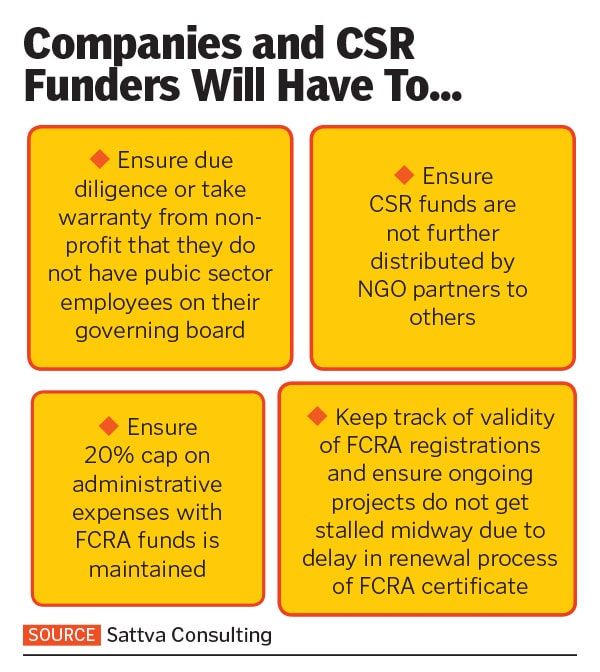 Right now, there is just “chaos” in the development sector as the rules have not yet been enforced, and there is no clarity on how organisations need to proceed. “Can I continue transacting with my existing bank accounts or do I need to open an FCRA account in the State Bank of India (SBI), Delhi, right away? For me, this is no different from demonetisation. We have to pause ongoing programmes and everything is coming to a standstill.”
Right now, there is just “chaos” in the development sector as the rules have not yet been enforced, and there is no clarity on how organisations need to proceed. “Can I continue transacting with my existing bank accounts or do I need to open an FCRA account in the State Bank of India (SBI), Delhi, right away? For me, this is no different from demonetisation. We have to pause ongoing programmes and everything is coming to a standstill.”




